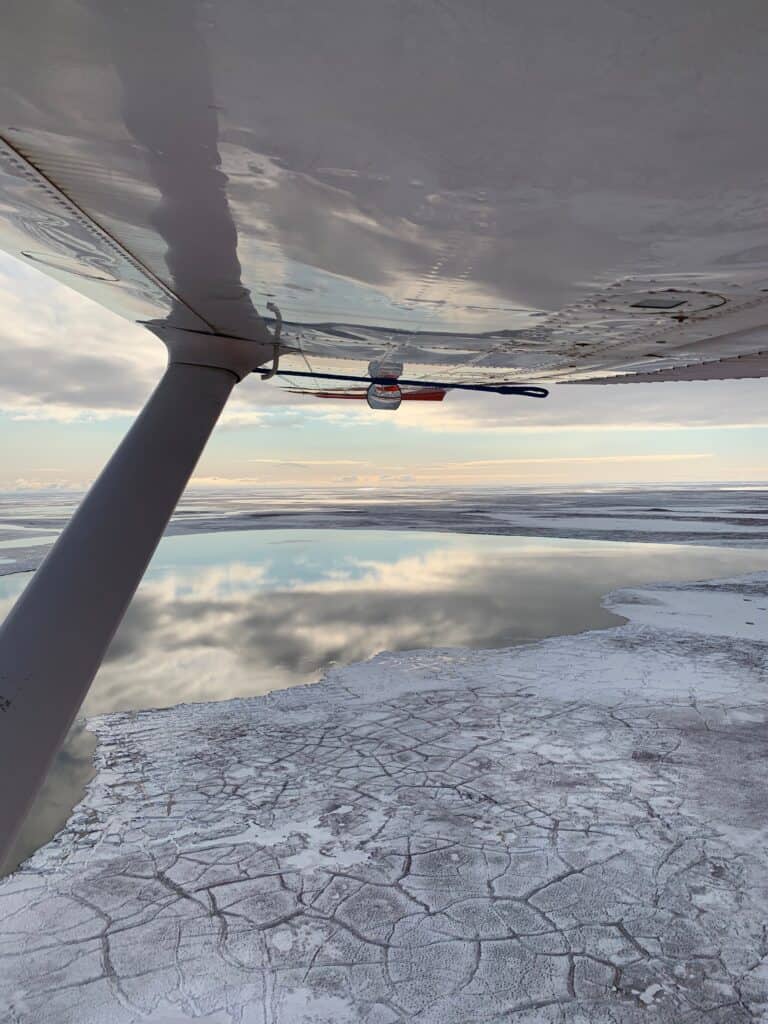Share this article
Wildlife Featured in this article
- Polar bear
JWM: Low-flying aircraft affect polar bear behavior
Low-flying aircraft may spook polar bears in remote parts of Alaska that rarely see other direct human intrusions.
A loss in sea ice due to climate change is driving polar bears to spend more time on land, where they might come into contact with humans, plans and helicopters more often.
By better understanding the minimum altitude at which planes and helicopters are able to fly before disturbing bears, wildlife managers can set better flight regulations in an airspace that’s growing increasingly busy as the north coast of the state develops.
“The U.S. Fish and Wildlife Service tries to minimize disturbance to [polar bears],” said Todd Brinkman, associate professor of wildlife ecology at the University of Alaska Fairbanks.
As a result, the agency has set altitude guidelines on how low aircraft can fly in polar bear regions. But these are based only on guesses about what might be a safe height to avoid disturbance.

In a study published recently in the Journal of Wildlife Management, Brinkman and his colleagues set out to test levels of disturbance by actually disturbing the bears.
“To me, it still is a little bit crazy that we were flying over and disturbing this threatened species,” Brinkman said. But, he said, this was the only way to retrieve data that could better inform pilots to stop disturbing them in the future. “The short-term disturbance will likely generate long-term conservation benefits for generations of bears.”

For a week in September 2021 and another week in September 2022—a period before the sea ice came back and before the snow on the ground returned and made it much more difficult to spot white bears from an aircraft—Brinkman and his colleagues flew around in both helicopters and airplanes searching for bears on the north coast of Alaska.
“It’s almost surreal at times—you just feel so fortunate to do this as your job,” Brinkman said.
Once the team spotted a bear, they would fly over it at a certain height, then turn back and fly at a lower height. They typically started at about 1,500-2,000 feet above a bear. They would fly back and forth over the bear multiple times until the bear showed a strong response, or until the aircraft reached 100 feet. If the bear showed any strong response, such as running away, or if a female stopped nursing a cub, for example, the researchers would record the altitude and leave the area.
In total, the team sampled 115 bears. They found that bears sometimes reacted to flyovers as high as 1,500 feet in both planes and choppers.

Overall, bears were more sensitive to helicopters than they were to planes, they found. The probability of disturbance increased when researchers flew lower than 450 meters above bears in helicopters. With planes, the chance of disturbance only substantially increased when they flew lower than 300 meters over the animals.
This could be because helicopters are noisier. In other cases, individual bears might have had previous encounters where wildlife managers chased and captured them from helicopters—they may recognize these aircraft as a threat.
They also found that active bears were more likely to respond to aircraft than bears that were lying down. If they were already vigilant, they were more likely to react.
In general, Brinkman said these results suggest that pilots would want to avoid altitudes less than 1,500 feet above bears.
This information can inform future planning for wildlife management, particularly with regards to permitting new developments in the area, such as oil and gas. When planning for new oil fields or other such developments, for example, these industries are only allowed a certain number of takes or disturbances. Now wildlife managers can better predict how many disturbances the aircraft from these areas might cause.
“[The standard for safe flying] needs to be defensible and not arbitrary,” Brinkman said.
This article features research that was published in a TWS peer-reviewed journal. Individual online access to all TWS journal articles is a benefit of membership. Join TWS now to read the latest in wildlife research.
Header Image: A polar bear appears as little more than a white speck on the ground from an airplane. Credit: Todd Brinkman








